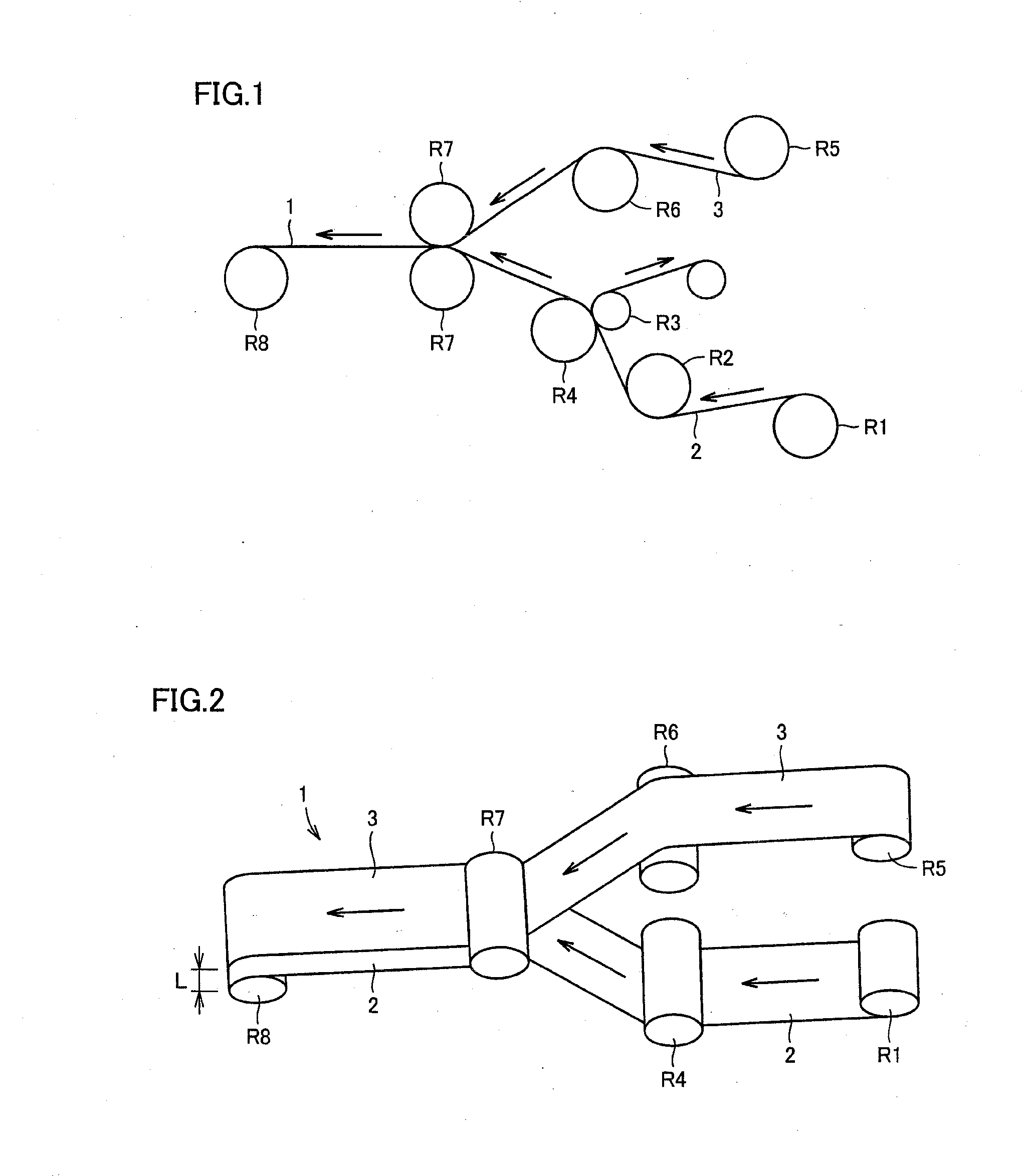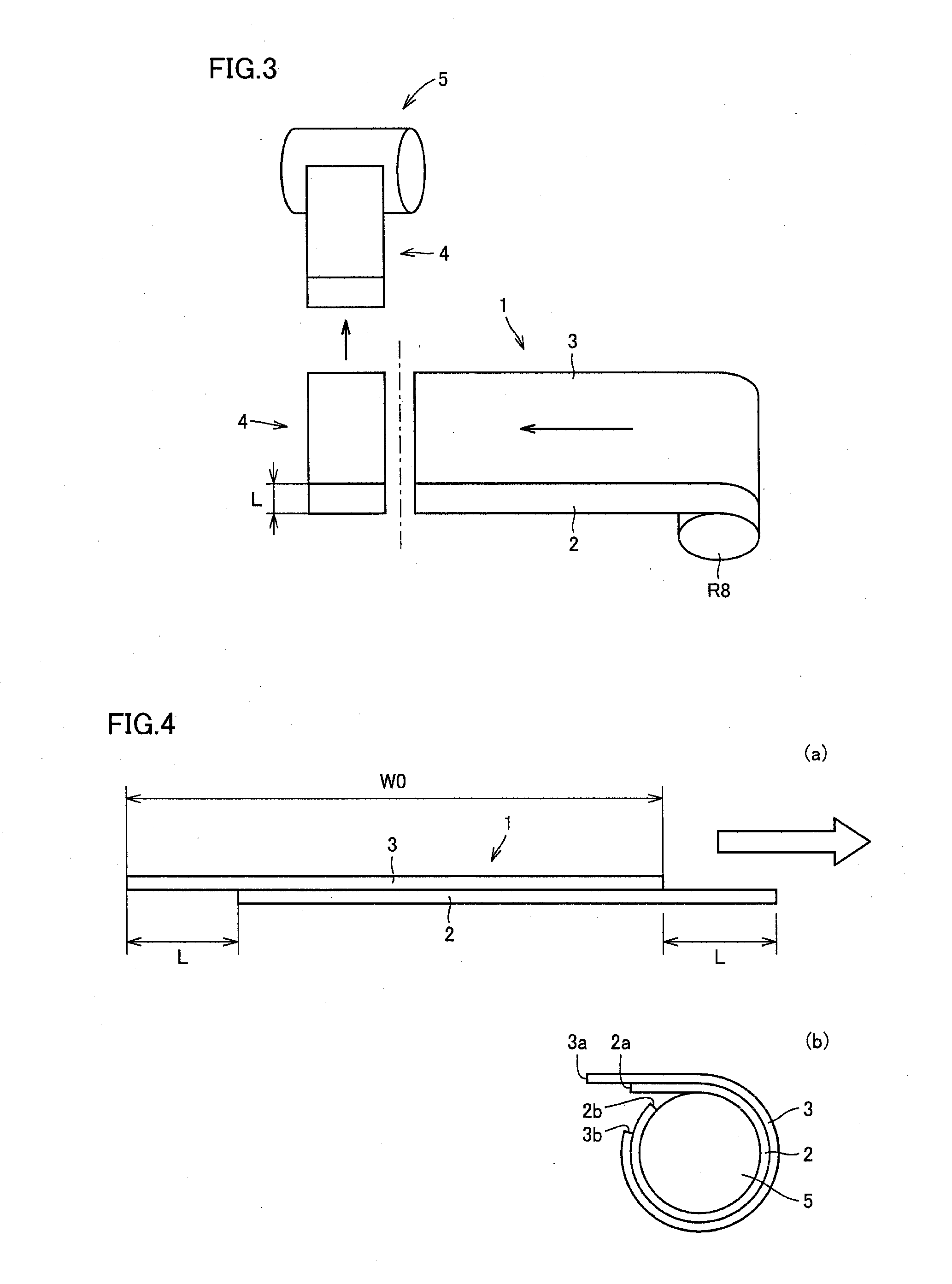Method for manufacturing pneumatic tire
- Summary
- Abstract
- Description
- Claims
- Application Information
AI Technical Summary
Benefits of technology
Problems solved by technology
Method used
Image
Examples
embodiment 1
[0037]
[0038]FIG. 1 is a schematic lateral view showing the assembly step, and FIG. 2 is a schematic perspective view showing the assembly step. In FIGS. 1 and 2, a film-like inner liner 2 covered with exfoliate paper is fed from a storage roll R1 via a first drive roller R2 in a direction indicated by an arrow, and is separated from the exfoliate paper at peel-off rollers R3, R4. Then, inner liner 2 is fed to a pair of calender rolls R7.
[0039]On the other hand, an unvulcanized rubber sheet 3 is fed via a second drive roller R6 to the pair of calender rolls R7. Inner liner 2 and unvulcanized rubber sheet 3 are bonded there to manufacture a laminate 1. Laminate 1 is taken up by a take-up roll R8 for temporary storage, or is continuously fed to the subsequent cutting step. Here, inner liner 2 and unvulcanized rubber sheet 3 having a substantially identical width are used, and positions of their both ends are displaced from each other to form a distance L.
[0040]Here, displaced distance ...
embodiment 2
[0049]Although inner liner 2 and unvulcanized rubber sheet 3 having an identical width are used in Embodiment 1, inner liner 2 in the present embodiment has a width W2 formed to be larger than a width W1 of unvulcanized rubber sheet 3.
[0050]FIG. 5 is a schematic view showing the cutting step. Laminate 1 is fed from take-up roll R8, or continuously from the assembly step, to a cutter by a belt conveyer. Laminate 1 is cut to have a predetermined length in the longitudinal direction in accordance with the size of the tire to manufacture cut sheet 4. A conventional technique such as cutting with a knife can be adopted to cut the laminate. The cutting direction of cut sheet 4 corresponds to the circumferential direction of the drum, and the cutting length thereof in the longitudinal direction corresponds to the width direction of drum 5.
[0051]FIG. 6(a) is a cross sectional view of the laminate, and FIG. 6(b) is a schematic view showing the state where the laminate is wound on the drum. H...
examples
[0088]
[0089]The styrene-based thermoplastic elastomers (SIB, SIBS, and SIS) used to manufacture the polymer laminate composed of the first layer and the second layer used as the inner liner in accordance with the present invention were prepared as described below.
[0090][SIB]
[0091]In a 2 L reaction vessel equipped with a stirrer, 589 mL of methylcyclohexane (dried over molecular sieves), 613 mL of n-butyl chloride (dried over molecular sieves), and 0.550 g of cumyl chloride were charged. After cooling the reaction vessel to −70° C., 0.35 mL of α-picoline (2-methylpyridine) and 179 mL of isobutylene were added. Further, 9.4 mL of titanium tetrachloride was added to start polymerization, and then the solution was reacted for 2.0 hours while being stirred at −70° C. Next, 59 mL of styrene was added into the reaction vessel and the reaction was continued for another 60 minutes, and then the reaction was terminated by adding a large amount of methanol. After removing the solvent and the l...
PUM
 Login to View More
Login to View More Abstract
Description
Claims
Application Information
 Login to View More
Login to View More - R&D
- Intellectual Property
- Life Sciences
- Materials
- Tech Scout
- Unparalleled Data Quality
- Higher Quality Content
- 60% Fewer Hallucinations
Browse by: Latest US Patents, China's latest patents, Technical Efficacy Thesaurus, Application Domain, Technology Topic, Popular Technical Reports.
© 2025 PatSnap. All rights reserved.Legal|Privacy policy|Modern Slavery Act Transparency Statement|Sitemap|About US| Contact US: help@patsnap.com



